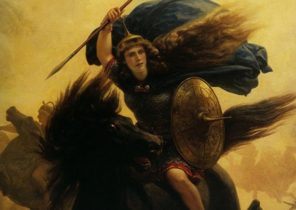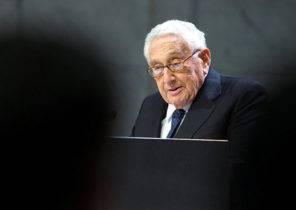
Last spring during a trip to Erfurt, the medieval University town in Germany famous for its Augustinian monastery where Martin Luther was ordained a priest, I learned that only twenty percent of its population profess Christianity. In fact, when talking about religion with a young woman in the lobby, I asked her if she goes to Church, she replied without hesitation: Ich bin Heide — “I am a Gentile.”
It is hardly surprising the existence of Gentiles in the heart of Western Europe, where once flourished Christianity the number of Christians is declining rapidly for the past several generations, even centuries. What surprised me is the lack of embarrassment in the woman, who called himself “a Gentile.” She didn’t say that he no longer goes to Church or believes in God. For her Christianity, who was no doubt the religion of her grandparents, and even parents, is something very far. I remembered that a couple of days before my train stopped in Fulda, where he is buried “Apostle of the Germans” of St. Boniface. At the time he arrived in Germany to convert the pagans, and made a bold and courageous move by chopping down their sacred oak in Geismar. The amazed observers and soon heeded the sermons of Boniface, and was baptized. It seems that in the case of the return of Christianity to the lands between the Rhine and the Elbe, for the destruction of the sacred oak trees of European secularism will need a new Boniface.
During a trip to Europe even deeper impression on me discussion about the Preface to the new Constitution of the European Union. I lived at the time in Italy and learned about the developments from the Italian press. All EU countries are historically Christian, and the idea of Europe — the fruit of Christian civilization. After all, the Carolingians, the Christian kings, was the first to unite the peoples of the West and East of the Rhine in a political Union, received the blessing of the Bishop of Rome. The history of Europe is a spiritual drama that is driven by religious beliefs rather than geography, economy and technology. But the creators of the EU Constitution refuse to even mention Christianity in the Preface to it. Readily acknowledging the legacy of pagan Greece and Rome, and even of Education, representatives of the political and bureaucratic elite of Europe chose to exclude any mention of Christianity from its history. They are not just deprived of Christianity role in the future of Europe, but I have eradicated it from her past. The question is, will the new Europe who fled Christian lands, to continue to promote the spiritual values that made Western civilization unique?
Talking with a young woman in Erfurt and listening to disputes about the EU Constitution, I thought about the future of Christian culture. In my lifetime people have witnessed the decline of Christian civilization. At first the process was a slow, gradual and persistent weakening, but today he received a significant acceleration, and that worries me the most, was conscious and deliberate, which not only contribute to the secular haters of Christianity, but often indulge themselves Christians.
Take, for example, calendar. I’m not talking about how Santa Claus has replaced baby Jesus or as the Easter Bunny has replaced the Resurrection of Christ. I also do not mean the transfer of the holidays falling on the middle of the week (e.g., Epiphany or Pentecost or All Saints Day), on Sunday. I’m talking about a dramatic, widespread deprivation of the resurrection of the status of the Holy day. Sunday morning in stores Home Depot and Lowe’s queue came over the banks of paint, boards and sealing with mastic people length is not inferior to the Sabbath. The only difference between Sunday and other days of the week is the hours of operation of shopping centres. The clergy and particularly the bishops of the Catholic Church, was complicit in the desacralization of Sunday as a Church festival, when established late Saturday Liturgy, called the all-night vigil. Believers have the opportunity to fulfill their obligations to God, popped into the Church for half an hour on Saturday evening and Sunday are left to themselves without the pesky inconvenience of family charges on the sermon.
Someone, of course, argue that in the US (unlike Europe) the churches thrive, and the number of Christians is growing. Yes, in America many Christians, but if we can still consider yourself Christian? If there is anything other than personal beliefs (as people say, if you ask them) or needs to visit the Church, it is pointless to deny that the influence of Christianity on the life and traditions of our society is on the wane. And the decline will likely continue. Which leads to the question: how long can hold the Christian faith — no matter how enthusiastic about it they say the evangelists, how ably expounded its dogmas, theologians and philosophers, or how well it translated into the language of the intellectual class, apologists without makeup from the Christian culture? I don’t mean high culture (“Mass b minor” or Bach’s “the Calling of St. Matthew” by Caravaggio); I mean “the common heritage of thought and feeling”, as described by Thomas Stearns Eliot — a set of inherited mentality and feelings encoded in rituals, law, language, customs and stories that are able to prescribe, to stimulate and guide the behavior, thoughts and feelings of the Christian people.
In such thinking the classical distinction between Christ and culture, popularized in the 1950-ies thanks to the eponymous book by Richard Niebuhr, would be of little use. At some point, but this is only in my opinion that one of the difficulties of his analysis is that the term “culture” is used as an alternative definition of “world,” the unredeemed territories inhabited by people. For Niebuhr the question is how the gospel, Christ enters the world and culture without loss of identity.
However, I think that the lack of schema “Christ and culture” lies not so much in understanding Niebuhr culture, as in his view of Christ. In the concept of Niebuhr Christ is the theological idea, and most of his books is a study of Christian thinkers, embodying five basic types of relations between this theological idea and culture. Niebuhr barely mentions the real historical experience of the Church culture, structures such as the episcopate and the papacy (there is no mention of Gregory VII and the struggle for the right of investiture), monasticism, civil and Canon law, the calendar, and the distribution of urban public space (standing in the Central square of the city Church). But Christ entered into history as a brotherhood, the society, and not simply the message; and form of life of the brotherhood is the Christ within society. The Church, self-culture. Christ is not just anchored in the culture, it creates culture by forming another city, another sovereign state with its own social and political life.
Based on these — although rather superficial — reasons, let me focus on three moments in the history of the Church, in order to demonstrate how Christ becomes the culture exists as a culture.
By the middle of the second century Christians be known in the Roman world, but do not detect features that associate them with any community. In an oft cited passage from the so-called “Epistle to Diognetus” (which is, in fact, an apology), Christians are distinguished from others not by nationality, language or customs. They have their own cities and way of life inconspicuous. It was known that the Christians worshiped Christ as God, refused to worship the Greek and Roman gods and goddesses, and regularly gathered for the ritual meal. Other distinguishing features they have virtually no. They gathered in the homes of the most wealthy followers in the prayers used in the city in which they lived; they had no private land, no churches (or indeed any buildings), or cemeteries, or religious calendar. The Bishop was not a public figure, and the Church as a social entity distinguished by its invisibility.
Take, for example, the earliest Christian art. If a Christian, who lived in 200 BC, I’d like to have in your home something for the artistic expression of the Christian faith, what would it be? He would go to the craftsman and chose the lamp with engraved symbol that could be interpreted as a Christian: the dove, fish, ship, anchor, or by a shepherd carrying a lamb. In a Christian home, the symbol for the Romans had one meaning, and received another, Christian: the dove as the embodiment of meekness; fish — Jesus Christ, Son of God, the Savior, the shepherd of humanity, or Christ as the good shepherd. Buying and showing other such items — lamps, rings or seal — Christians created the first (known to us) Christian art, but what those symbols represented, was laid not in the object itself, but acquired meaning in the eyes of the beholder. With regard to Roman society, Christianity in it was invisible.
However, in the early third century the Christians in Rome decided on a bold step. They pooled resources to buy a plot of land on the Old Appian way outside the city; there they built an underground tomb and hired artists to decorate walls and ceilings with frescoes. Oversaw the construction of a Roman Christian by the name Kallistos, became later the Bishop of Rome. Today this place is known as the catacombs of St. callixtus. Of the paintings survived only a few, but over by the catacombs was almost no power. It’s not just the number of burial niches, and a huge underground cemetery with chapels ceiling, tiled walls and artistic painting depicting people and stories from the Bible. Its construction represents an organized effort (diggers, designers, plasterers and painters) on behalf of the Christian community in Rome to create a truly Christian place. The catacombs were not secret refuge during the persecutions; they were burial grounds and religious buildings, and their whereabouts are no mystery not. When Christians buried their dead, or left in the catacombs to take communion, and their activities were obvious to all citizens.
The construction of the Christian catacombs required the preparation of and means for choosing the format and entourage, as well as pay workers. Most areas have a square shape, which allowed to capture on covered with white plaster ceiling symmetric patterns. The center of the ceiling of each room is decorated with a medallion with some relief. In some rooms of the medallions depicts the figure of a young shepherd carrying a lamb on his shoulders. Other frescoes can be seen Orpheus (under it should be understood of Christ) with his lyre in hand and surrounded by animals (as said by Clement of Alexandria, Christ, unlike Orpheus, is able to tame even the most wild of animals, man) and the heroic figure of a naked Daniel and Jonah, who is thrown overboard. Adding to the form inherent in Roman art, murals with images of Abraham, Isaac, Moses striking water from the rock in the desert, Daniel in the lion’s den and Jesus baptized in the Jordan, the Romans Christians created a truly unique sanctuary.
Something similar to that taken by Christians on the Old Appian way happened in other Christian communities of that time. According to the art historian Corby Finney, “was a cultural event of a particular value”, and here we see “the transition from being virtually invisible models of accommodation and adaptation to a new level of Christian identity, it is tangible and visible”. For the first time, Christians began to create “material culture”, something tangible, occupies space, public (albeit underground) and purely Christian.
Christians, designed and built these catacombs, as thought seriously about his endeavor, how many bishops and philosophers have invested in the idea of protecting the faith, the interpretation of Scripture or challenging the arguments of the critics. What is particularly important, for the first time, Christian culture takes material form in relation to the care and the memories of the dead. Memory, especially of the faithful departed, is a defining characteristic of Christian identity. Live United the power of their prayers with the prayers of the saints, which, according to the book of Revelation, was a “Golden bowls full of incense.” Organizing the community for the construction of a burial place and its decoration with frescoes with images of biblical stories, Christians formed a collective public consciousness, which will last for many generations. As stated in the apostles ‘ creed (in the earliest sense): “we Believe in the communion of saints.” Their aim was not the explanation of the gospel to other cultures, and cultivating internal peace of the Church.
The second point regarding the consideration of Christ as culture refers to a later period, and here we are not talking about space as about time, but about the creation of the Christian calendar. Theologians and biblical scholars have attached great importance to the understanding of the New Testament Kairos, a time of momentous events, the long-awaited extraordinary moment. “… the time is fulfilled, and the Kingdom of God; repent and believe the gospel” (mark 1:15). But there is another kind of time, which is a count of days and seasons. The early Christians only one day — the day of the resurrection was celebrated whenever the community meetings, usually on Sundays. Already in the book of revelation there is mention of “the Lord’s day,” the Kyriake Hemera (Revelation 1:10), as in the teaching of the twelve apostles (Didache, Chapter 14). By the middle of the second century Christians began to celebrate the annual festival, Easter festival (the death and resurrection of Christ), which began with the vigil on Saturday evening and continued until morning.
Over time, and other holidays. Christmas in Rome was celebrated in the middle of the fourth century. Around the same time for the Roman Christians was composed of calendar, called Chronograph of the year 354, in which were listed the dates of holidays, the burial of Roman bishops and martyrs, and Christmas — all in the calendar, and not the historical order. “On the eighth day of the calends of January, Christ was born in Bethlehem of Judea”. Christmas soon joined the feast of the visitation, held forty days after his birth. Was appointed the celebration of the ascension and of Pentecost. The Christian year consists of two core cycles, which was the birth of Christ on one side and his suffering, death and resurrection. Like most ancient (and later) Christian art, the Church year (as we now call him) had a narrative form and are based on the Scriptures, especially the gospel. Through ritual, biblical narrative imprinted in the minds and hearts of believers from the point of view of not only intimacy with God, but full public process that sets the rhythm of life of the community.
In the beginning of the third century, Christians constituted less than one percent of the sixty millionth of the population of the Roman Empire. By 300 ad the Empire was hardly there were six million Christians, but by mid-century their number exceeded 30 million, which accounted for about half of the total population. This rapid growth took place against the background of the conversion of Emperor Constantine to Christianity and his vigorous program of construction of churches, changing public law practice. It is noteworthy that the Christian calendar was the civil. In 321 Constantine declared Sunday a public holiday. Vulgar and absurd to criticize the political aspects of the reign of the Emperor Constantine, while ignoring the desire of early Christians to impose the imprint of the face of Christ to their society, in order of time, architecture and the law (e.g., prohibition of the practice of throwing babies, the traditional form of “birth control”). Purpose of announcement of the resurrection Church holiday was giving Christians time to attend worship services, but as a “side effect” it also has made Sunday a day of rest, thus laying the groundwork for the emergence of the Holy day of the Sabbath.
We should not forget that the prosperity of Christianity also changed the manner of recording of the course of historical time. Dionysius the Small, a Scythian monk of the sixth century, was the first to designate the years from the “incarnation of our Lord Jesus Christ” (Anno Domini, ad). The scheme adopted in England in the seventh century at the Synod of Whitby, after which it used the Venerable Bede in his “Ecclesiastical history of the English people”.
Calendar to Christmas, Candlemas, Easter, Ascension and Pentecost were added special days for the veneration of martyrs and saints. Over time important events — changing of the seasons, sowing and harvest, slaughter of animals — were celebrated in the days of the patron saints of the activity or event from the life of Christ.
The Church calendar makes a religious commemoration of a familiar and understandable. The repetition of the days of the veneration of saints and feasts of the Lord became a kind of spiritual metronome, helping the community to develop in harmony with the ordinances of the faith.
Do not underestimate the cultural significance of the calendar and its indispensability in the attitude of a Mature spiritual life. Religious rituals are the echoes of human feelings, accumulated over the centuries. They are not easy to create and difficult to recover after idling. They affect us far more than public celebrations such as Fourth of July or memorial Day warriors. The period of advent, for example, is quite predictable reminder that Christians live at a different time noting important events in the family through simple rituals such as ignition purple candles on an evergreen Christmas wreath dark evening in early December.
Festive days and weeks offer regular and fixed periods of interruption, and, consequently, the possibility of rest (a precondition of culture, as taught to us by Josef Pieper). The holidays provide a time for reflection and contemplation, which open the way to the sacraments and confer a sense of belonging to something higher. How soon wrote Wystan Hugh Auden, “at the end of the days of meekness we will have to return to the world where there is work, money and good manners.”
The third aspect of formation within Christianity’s own culture is language. Historian Henry Marra in his dissertation, “St. Augustine and the late antique culture” describes the grammatical and rhetorical environment of the Roman Empire in the late fourth century, in which Augustine was educated. According to him, in the days of Augustine educated Christians enjoyed the privileges and benefits that have existed for centuries in the educational system. When Augustine wrote his treatise “On Christian doctrine” (reasoning on the interpretation and explanation of the Scriptures), he probably assumed that his readers know Latin grammar and standard rhetorical techniques.
But a hundred years later such knowledge was no longer to be taken for granted. Few cities can cover costs associated with pay of teachers and maintenance of schools. Since the sixth century, in the bosom of the Church, a number of eminent teachers, such as Boethius, Cassiodorus, Benedict of Nursia, Isidore of Seville and Bede. In contrast to Augustine, their mission was the conversion obtained is rather a preservation and transfer forgotten or interpretation unreadable. Now Christianity has assumed responsibility for the management mechanisms of the Latin language.
Cassiodorus was born in 485 year in the family of an Italian Senator. In later years he served at the court of the ostrogothic kings of Italy, devoting his literary talents to the drafting of decrees and official letters, as well as fixing significant events. At the age of seventy years, he returned home and founded a monastery at Squillace on the South coast of Italy. He moved to his library and gathered a group of scientists for making copies from the sacred Scriptures and classical works of Latin Christian literature, a translation of Greek books and the creation of compendia (Handbook) of the Christian and secular teachings.
Compendi Cassiodoro is markedly different from the writings of Augustine, Ambrose, or Jerome. His main goal was to give readers a basic knowledge of the Bible. Cassiodorus begins with list, order and separation of books of Scripture, their interpretation, and brief comments about Christian preachers, such as Hilary, Cyprian, Ambrose and Jerome. But then, the reader stumbles upon a Chapter entitled “the scribes and the remembrance of spelling.” In the second part of the book, the grammar is devoted to a section entitled “foundations of liberal studies”. The aim of the author was to transfer the basic knowledge of grammar and rhetoric for the sake of creating accurate copies of the Scriptures, “for every word of the Lord written by the scribe, is striking a blow to Satan”. When Cassiodorus was ninety, he composed the treatise “On orthography”, a kind of guide for enumerators. (Latin letters V and B gave especially a lot of trouble to those who worked on the ears).
Another writer, renowned for his studies of grammar, linguistics, and other fields of knowledge, is a Spanish Bishop Isidore of Seville. Although a first-class thinker, he was not on the sidelines he was quite comfortable. (Dante identified him on the fourth heaven, along with the Venerable Bede and Richard of Saint-VectorSeis). He was born in the family of the local nobility of Cartagena and was educated at the convent school of Seville under the guidance of his brother Leander, who was at that time Bishop of the city. 600 year he replaced brother on this post and later had a significant influence on the rituals and laws of the Spanish Church.
A huge encyclopedia of Isidore, entitled “Etymology” is an attempt to summarize all knowledge on the basis of extensive Treasury of classical writers, and his work “Liber differentiarum sive de proprietate sermonum,” examines the meaning of words and distinctions that are necessary for their proper use (like tablerowcolor “Dictionary of contemporary English usage”).
Isidore recognized that grammar, “the science of correct expression of thought”, is crucial from the point of view of not only reading, writing and speaking, but also thinking and understanding. Grammar is the knowledge of how language works, and the norms regulating the relations of words and concepts. Without grammar is impossible to pass the text of Scripture, nor understanding of its contents, nor, consequently, grammar, no Christian culture.
Culture lives in language, mood, thoughts and feelings of a Christian culture are formed and implemented through the language of Scripture. St Augustine, for example, believed in the existence of a characteristic only one Christianity language, dubbed it “the ecclesiastical manner of speaking” (ecclesiastica loquendi consuetudo). He believed that the term “Martyr” (lat. martyr – witness) was sanctioned by the Bible (especially in the first chapters of the “acts of the apostles”) and sanctified by the traditions of early Christianity. Augustine said that his replacement on the ordinary Latin designation of the word “hero”, vir, would be contrary to Church traditions. Salvator (Savior) is another biblical word with a strong Christian overtones: natus est vobis hodie Salvator, qui est Christus in civitate David Dominu (for unto you is born in the city of David a Saviour, which is Christ the Lord). Generally accepted Latin word salus meant health, not salvation. However, Christians coined the words salvare (to save) and salvator (Savior); in doing this they laid the Foundation for the emergence of a Christian language formed by Scripture.
In a Christian culture is absolutely indispensable words and phrases that are in constant use shape our imagination and direct our emotions: “obedience,” “grace,” “long-suffering” (the biblical form of the term “patience”), “image of God”, ” suffering servant,” “adoption,” “the will of God.” The reading of the Psalms day by day, week by week, transform the words of psalmodize of the texts that need translation, in the words that we use in order to magnify, to pray, to thank and glorify God, as well as those through which we understand ourselves before him: “o my Lord! You have searched me and known me!… Still no word on my tongue, You, Lord, know it completely”.
Since Christianity has its own language, we need to be careful to any attempt its translation. We will not be able to pass to the next generation the meaning of words if we do not cling to them. Jerusalem can not be a Paris or Moscow or new York without losing its rootedness in the biblical narrative. Some words should be used in the same form in which they were in Christian speech, for example, “Father”, “Son”, “Holy Spirit”, “Lord” (as in “Lord, have mercy”), “glory” (as in the gospel of John in the narrative of the passion of Christ), sin (“against you only I have sinned”), “destroy” (as in “made Himself nothing, taking the form of a servant”), “resurrection” (as in “raised from the dead on the third day”), “flesh” (as in “works of the flesh”, meaning a conscious action, such as idolatry and jealousy, not only the sins of the body, such as fornication) and even “I” (as in the parable of the older brother: he “came to himself”). Christian culture does not replace the concept of “I” with the word “recover” as in the Catholic Lectionary; also she’s not going to paraphrase, ignorance or guided by the ideology of the first verse of Psalm 1, turning “blessed is the man,” “blessed are those who” (as does New revised Standard version of the Bible), thereby eliminating the ancient Christological interpretation of the Psalm.
Material culture and with it art and the calendar, rituals and grammar as well as language, particularly the language of the Bible — these are just some of many examples (among others a monk), which can lead to demonstrate the extraordinary density of Christian culture, the fullness of life in society, which is the embodiment of Christ on earth.
Today there is nothing more important than the survival of Christian culture, because in recent generations this culture is dangerously thinned. At the moment in this country (and the West in General) representatives of the alternative culture in which we live, in the truth of Christ, is not so important as the need of the Church to tell their own story and develop their own life, culture, the city of the Lord, the Christian Republic. This will not happen without a revival of moral and spiritual discipline, and a determined effort by Christians to understand and protect the remnants of Christian culture. The sad fact is that the society in which we live has lost neutrality with regard to Christianity. In the United States atmosphere conducive to the observance of religious traditions, could become much less favourable if our public life has lost all signs of Christian culture, and Christian behavior would be allowed only in certain situations.
If the Christian culture is destined to change, the traditions will become more important than spiritual rebirth, rituals nazidatelnye spiritual heights, dogma — penetration of the theological revelations, and celebrations of saints ‘ days — more to elevate the soul than the celebration of mother’s Day. Great wisdom inherent in criticizing the phrase ex opere operato, “by virtue of this deed.” The intention like a reed in the wind. The importance is the act, and if we do something for God, God also does something for us.
Poet Dan Gioia, the current Director of the National endowment for the arts, talks about this in his poem “the First autumn”:
There will always be those who do not honor the celebrations
who insists that unnecessary fanfare,
let determination the path will open to us
and strong will become weak in spirit,
like a desert Saint, that the only faith lives
not looking for sanctuaries in the decoration.
Gioia reiterates this idea again:
Characters lie,
reflecting not everything in them is hidden.
And then:
But will the torches to light the way
To those who are poor in spirit, and more?
Let the splendor of the rites gives a new chance
to write the book of life first;
the fire will not go out in the rebellious soul
enveloped in the experience of ancestors,
But will give her the opportunity to be cleansed at once
Shine even brighter than before.
Admit that worship is not the ritual itself,
but the point of living for centuries.
And before the contemplator of it,
what is worthy of the attention of God:
carelessness of lovers who have forgotten the whole world,
or a cry from the bath-sounding.
If Christ is culture, let in the eve of Easter sidewalks light up by the lights, let the spring morning, the whole city freezes, skipping a column of Christians waving palm branches, let them block the street, when the believers will gather on the feast of the body and blood of Christ. Let the others know that there is in this world another town, another community, whose opinion, like the opinions of angels, directed to God.
Robert Louis Wilken is Professor of history of Christianity at the University of Virginia. The original version of this article was delivered at the Center of theological research, Princeton, new Jersey.







